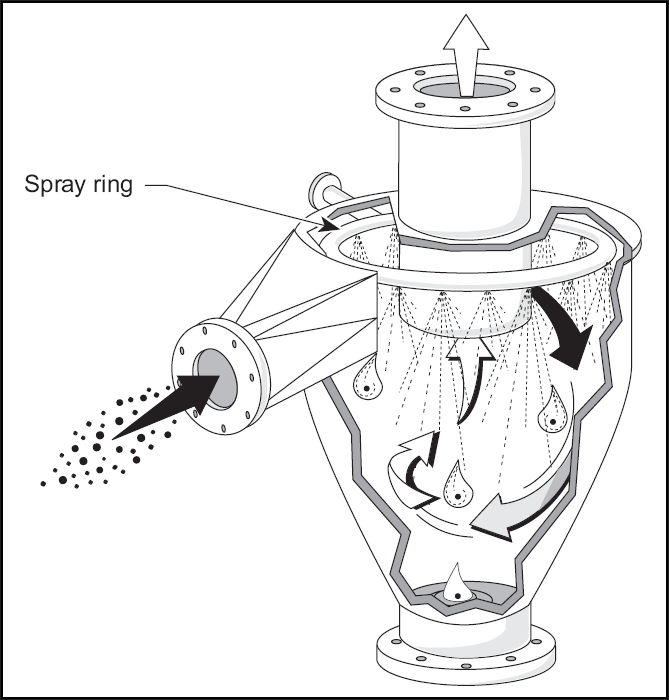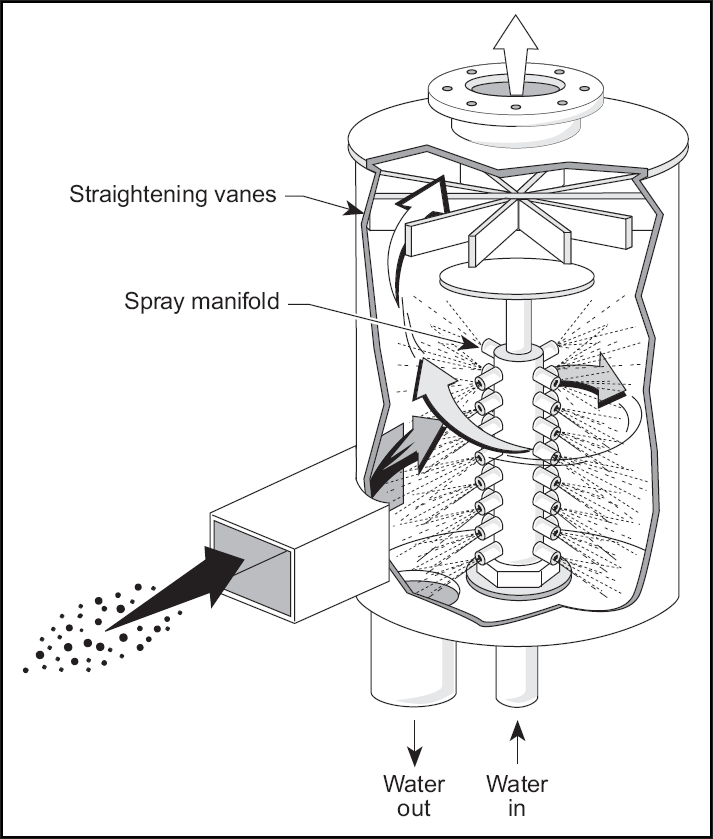
Cyclonic spray scrubber
Encyclopedia

Cyclonic separation
Cyclonic separation is a method of removing particulates from an air, gas or liquid stream, without the use of filters, through vortex separation. Rotational effects and gravity are used to separate mixtures of solids and fluids...
and the spray chamber
Spray tower
Spray towers or spray chambers are a form of pollution control technology. They consist of empty cylindrical vessels made of steel or plastic and nozzles that spray liquid into the vessels. The inlet gas stream usually enters the bottom of the tower and moves upward, while liquid is sprayed...
to remove pollutants from gas streams.
Generally, the inlet gas enters the chamber tangentially, swirls through the chamber in a corkscrew motion, and exits. At the same time, liquid is sprayed inside the chamber. As the gas swirls around the chamber, pollutant
Pollutant
A pollutant is a waste material that pollutes air, water or soil, and is the cause of pollution.Three factors determine the severity of a pollutant: its chemical nature, its concentration and its persistence. Some pollutants are biodegradable and therefore will not persist in the environment in the...
s are removed when they impact on liquid droplets, are thrown to the walls, and washed back down and out.
Cyclonic scrubbers are generally low- to medium-energy devices, with pressure drop
Pressure drop
Pressure drop is a term used to describe the decrease in pressure from one point in a pipe or tube to another point downstream. "Pressure drop" is the result of frictional forces on the fluid as it flows through the tube. The frictional forces are caused by a resistance to flow. The main...
s of 4 to 25 cm (1.5 to 10 in) of water. Commercially available designs include the irrigated cyclone scrubber and the cyclonic spray scrubber.
In the irrigated cyclone (Figure 1), the inlet gas enters near the top of the scrubber
Wet scrubber
The term wet scrubber describes a variety of devices that remove pollutants from a furnace flue gas or from other gas streams. In a wet scrubber, the polluted gas stream is brought into contact with the scrubbing liquid, by spraying it with the liquid, by forcing it through a pool of liquid, or by...
into the water sprays. The gas is forced to swirl downward, then change directions, and return upward in a tighter spiral. The liquid droplets produced capture the pollutants, are eventually thrown to the side walls, and carried out of the collector. The "cleaned" gas leaves through the top of the chamber.
The cyclonic spray scrubber (Figure 2) forces the inlet gas up through the chamber from a bottom tangential entry. Liquid sprayed from nozzles on a center post (manifold) is directed toward the chamber walls and through the swirling gas. As in the irrigated cyclone, liquid captures the pollutant, is forced to the walls, and washes out. The "cleaned" gas continues upward, exiting through the straightening vanes at the top of the chamber.
This type of technology is a part of the group of air pollution
Air pollution
Air pollution is the introduction of chemicals, particulate matter, or biological materials that cause harm or discomfort to humans or other living organisms, or cause damage to the natural environment or built environment, into the atmosphere....
controls collectively referred to as wet scrubber
Wet scrubber
The term wet scrubber describes a variety of devices that remove pollutants from a furnace flue gas or from other gas streams. In a wet scrubber, the polluted gas stream is brought into contact with the scrubbing liquid, by spraying it with the liquid, by forcing it through a pool of liquid, or by...
s.
Particulate collection

Spray tower
Spray towers or spray chambers are a form of pollution control technology. They consist of empty cylindrical vessels made of steel or plastic and nozzles that spray liquid into the vessels. The inlet gas stream usually enters the bottom of the tower and moves upward, while liquid is sprayed...
s, but not as efficient as venturi scrubber
Venturi scrubber
A venturi scrubber is designed to effectively use the energy from the inlet gas stream to atomize the liquid being used to scrub the gas stream...
s, in removing particulate from the inlet gas stream. Particulates larger than 5 µm are generally collected by impaction with 90% efficiency. In a simple spray tower
Spray tower
Spray towers or spray chambers are a form of pollution control technology. They consist of empty cylindrical vessels made of steel or plastic and nozzles that spray liquid into the vessels. The inlet gas stream usually enters the bottom of the tower and moves upward, while liquid is sprayed...
, the velocity of the particulates in the gas stream is low: 0.6 to 1.5 m/s (2 to 5 ft/s).
By introducing the inlet gas tangentially into the spray chamber, the cyclonic scrubber increases gas velocities (thus, particulate velocities) to approximately 60 to 180 m/s (200 to 600 ft/s). The velocity of the liquid spray is approximately the same in both devices. This higher particulate-to-liquid relative velocity increases particulate collection efficiency for this device over that of the spray chamber
Spray tower
Spray towers or spray chambers are a form of pollution control technology. They consist of empty cylindrical vessels made of steel or plastic and nozzles that spray liquid into the vessels. The inlet gas stream usually enters the bottom of the tower and moves upward, while liquid is sprayed...
. Gas velocities of 60 to 180 m/s are equivalent to those encountered in a venturi scrubber
Venturi scrubber
A venturi scrubber is designed to effectively use the energy from the inlet gas stream to atomize the liquid being used to scrub the gas stream...
.
However, cyclonic spray scrubbers are not as efficient as venturi scrubbers because they are not capable of producing the same degree of useful turbulence.
Gas collection
High gas velocities through these devices reduce the gas-liquid contact time, thus reducing absorption efficiency. Cyclonic spray scrubbers are capable of effectively removing some gases; however, they are rarely chosen when gaseous pollutant removal is the only concern.Maintenance problems
The main maintenance problems with cyclonic scrubbers are nozzle plugging and corrosionCorrosion
Corrosion is the disintegration of an engineered material into its constituent atoms due to chemical reactions with its surroundings. In the most common use of the word, this means electrochemical oxidation of metals in reaction with an oxidant such as oxygen...
or erosion of the side walls of the cyclone body. Nozzles have a tendency to plug from particulates
that are in the recycled liquid and/or particulates that are in the gas stream. The best solution is to install the nozzles so that they are easily accessible for cleaning or removal.
Due to high gas velocities, erosion of the side walls of the cyclone can also be a problem. Abrasion-resistant materials may be used to protect the cyclone body, especially at the inlet.
Summary
The pressure dropPressure drop
Pressure drop is a term used to describe the decrease in pressure from one point in a pipe or tube to another point downstream. "Pressure drop" is the result of frictional forces on the fluid as it flows through the tube. The frictional forces are caused by a resistance to flow. The main...
s across cyclonic scrubbers are usually 4 to 25 cm (1.5 to 10 in) of water; therefore, they are low- to medium-energy devices and are most often used to control large-sized particulates. Relatively simple devices, they resist plugging because of their open construction. They also have the additional advantage of acting as entrainment
Entrainment (engineering)
Entrainment as commonly used in various branches of engineering may be defined as the entrapment of one substance by another substance. For example:* The entrapment of liquid droplets or solid particulates in a flowing gas, as with smoke....
separators because of their shape. The liquid droplets are forced to the sides of the cyclone and removed prior to exiting the vessel. Their biggest disadvantages are that they are not capable of removing submicrometer partculates and they do not efficiently absorb most pollutant gases.
Table 1 lists typical operating characteristics of cyclonic scrubbers.
| Table 1. Operating characteristics of spray towers | |||||
|---|---|---|---|---|---|
| Pollutant | Pressure drop (Δp) | Liquid-to-gas ratio (L/G) | Liquid-inlet pressure (pL) | Removal efficiency | Applications |
| Gases | 4-25 cm of water (1.5-10 in of water) |
0.3-1.3 l/m3 (2-10 gal/1,000 ft3) | 280-2,800 kPa (40-400 psig) | Only effective for very soluble gases | Mining operations Drying operations Food processing Foundries |
| Particulates | 2-3 µm diameter | ||||

